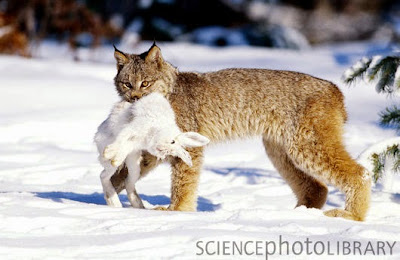Tuesday, March 10, 2015
Saving the Canadian Lynx: Jake Sikkema
As a young kid in grade school i was always fascinated with one particular animal: the Canada Lynx.
(http://www.nhptv.org/natureworks/lynx.htm)
This small mammal is well fitted for the snow, with large paws and long legs. It is highly adapted for hunting the Snowshoe Hare, it's main prey, in the snows of boreal, or coniferous, forests. It has a widely distributed range in the US, but mostly in Alaska and Canada. They prefer places with natural disturbances that provide foraging habitat for the Lynx and it's main food source: The Snowshoe Hare.
(http://thecanadianlynx.weebly.com/niche.html)
Without the Snowshoe Hare, the Lynx would have trouble surviving in the ecosystem. The Southernmost extent of their habitat occurs in the contiguous US in the Northeast, Western Great Lakes, the North and South Rockies and the Northern Cascades. They have a large home range, between 12-83 square miles; large patches of boreal forests will support a greater population than smaller patches. The Lynx have a higher density the more North you move in it's range, for there are more suitable conditions and a relative higher density of the Snowshoe Hare. As climate change warms up the planet, Lynx populations will move more North towards colder weather. A large Lynx population in Canada will ensure populations in the US as they emigrate South, for they are highly mobile and disperse over long distances. A core area is one that has occurrence of lynx over time and recent evidence of reproduction. So far, there are 6 core areas and one 'provisional' core area identified within the US.
(from the recovery plan)
There are several factors contributing to the March 24, 2000 Lynx's listing as threatened. Timber harvest and recreation are posing threats to their habitat. The primary factor is the lack of guidance for it's conservation as well as the Snowshoe Hare in National Forest Lands and BLM Land Use Plans. Although trapping of the Lynx in the US has been banned, it is still legal in Canada, where the source of their metapopulation is located. In 2000, the Forest Service and Bureau of Land Management (BLM) signed a 4 year conservation agreement but has not been very well kept and we need to look at long term conservation options. So far, only Washington's Department of Fish and Wildlife has adopted a Lynx Recovery Plan. Their strategy is to address threats to the habitat and species so its protection is no longer needed. Some of their objectives are to retain a good habitat to support long term populations in each identified core area in the US. Also to make sure there is persistent immigration and emigration between core and adjacent populations in Canada and the secondary areas in the US. Lastly they want to ensure that threats are addressed so the population will persist for at least 100 years.
Subscribe to:
Post Comments (Atom)



No comments:
Post a Comment